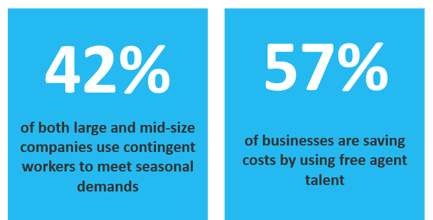 A recent Forbes report revealed that almost half of large and mid-size companies in the United States tapped on a contingent workforce to meet the highs and lows of seasonal demands. A contingent workforce comprises of non-employee or free agent talent, which includes independent contractors, freelancers, consultants and temporary workers.
A recent Forbes report revealed that almost half of large and mid-size companies in the United States tapped on a contingent workforce to meet the highs and lows of seasonal demands. A contingent workforce comprises of non-employee or free agent talent, which includes independent contractors, freelancers, consultants and temporary workers.
With the ever-growing presence of companies like Grab, Deliveroo, Honestbee, there has been an evident rise of the contingent workforce throughout the world. Against this backdrop, the labour market today is also faced with other challenges from an ageing population and a shortage of skilled workers.
Organizations therefore, are faced with these new dynamics when dealing with the labour market today. The need for a strategic workforce plan is never more crucial than now, as organizations need to ensure that they are well-equipped to handle these new dynamics for them to hire the right talent at the right time.
Changing Trends in Workforce
In view of this, face of strategic workforce planning has evolved. Traditional strategies which tended to be driven by finance and budgets (i.e. budget-driven headcount planning) has now matured with the incorporation of analytics. With analytics, these strategies have come to focus more on forecasting, or predictive analytics and a predictive workload, which in turn allows organization leaders to make informed decisions on the manpower they should be budgeting for (i.e. headcount/workload-driven budget planning).
Before you dismiss this new strategy as too “liberal” or if you still need more convincing, the reason behind this trend is simple. Having established the increasing volatility and the dynamic forces affecting the labour market, the key to mitigate is to have a workforce strategy that would enable the workforce to be flexible.

In the case of excess or shortage of manpower, a predictive workload gives the organization a forewarning, and by extension, ample reaction time, to plan for manpower. Having a deep awareness of one’s workforce capacity is especially vital for organizations when it comes to preparing for volatile, peak or lull seasons. This also allows you to effectively manage and optimize your workforce to equipped to respond to real-time business needs. Here, discussions regarding leveraging the contingent workforce can thus be made relevant and effective.
After all, it would not be contested that greater your ability at aligning your work demands with your workforce capability, the higher your chances of successful growth despite volatility.
*Statistics reported in this article can be found in this article: https://www.forbes.com/sites/abdullahimuhammed/2018/07/31/four-statistics-showing-how-business-can-benefit-from-the-gig-economy/#4345157e752f



